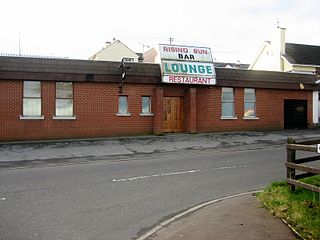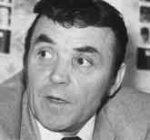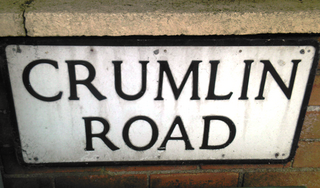
John Adair, better known as Johnny Adair or Mad Dog Adair, is an Ulster loyalist drug dealer and the former leader of the "C Company", 2nd Battalion Shankill Road, West Belfast Brigade of the Ulster Freedom Fighters (UFF). This was a cover name used by the Ulster Defence Association (UDA), a loyalist paramilitary organisation. In 2002 Adair was expelled from the organisation following a violent internal power struggle. Since 2003, he, his family and a number of supporters have been forced to leave Northern Ireland by the mainstream UDA.

The Ulster Defence Association (UDA) is an Ulster loyalist paramilitary group in Northern Ireland. It was formed in September 1971 as an umbrella group for various loyalist groups and undertook an armed campaign of almost 24 years as one of the participants of the Troubles. Its declared goal was to defend Ulster Protestant loyalist areas and to combat Irish republicanism, particularly the Provisional Irish Republican Army (IRA). In the 1970s, uniformed UDA members openly patrolled these areas armed with batons and held large marches and rallies. Within the UDA was a group tasked with launching paramilitary attacks that used the cover name Ulster Freedom Fighters (UFF) so that the UDA would not be outlawed. The British government proscribed the UFF as a terrorist group in November 1973, but the UDA itself was not proscribed until August 1992.
A loyalist feud refers to any of the sporadic feuds which have erupted almost routinely between Northern Ireland's various loyalist paramilitary groups during and after the ethno-political conflict known as the Troubles broke out in 1969. The feuds have frequently involved problems between and within the Ulster Defence Association (UDA) and the Ulster Volunteer Force (UVF) as well as, later, the Loyalist Volunteer Force (LVF).

The Shankill Road bombing was carried out by the Provisional Irish Republican Army (IRA) on 23 October 1993 and is one of the most well-known incidents of the Troubles in Northern Ireland. The IRA aimed to assassinate the leadership of the loyalist Ulster Defence Association (UDA), supposedly attending a meeting above Frizzell's fish shop on the Shankill Road, Belfast. Two IRA members disguised as deliverymen entered the shop carrying a bomb, which detonated prematurely. Ten people were killed: one of the IRA bombers, a UDA member and eight Protestant civilians, two of whom were children. More than fifty people were wounded. The targeted office was empty at the time of the bombing, but the IRA had allegedly realised that the tightly packed area below would inevitably cause "collateral damage" of civilian casualties and continued regardless. However, the IRA have denied this saying that they intended to evacuate the civilians before the explosion. It is alleged, and unearthed MI5 documents appear to prove, that British intelligence failed to act on a tip off about the bombing.

The Greysteel massacre was a mass shooting that took place on the evening of 30 October 1993 in Greysteel, County Londonderry, Northern Ireland. Members of the Ulster Defence Association (UDA), a loyalist paramilitary group, opened fire on civilians in a crowded pub during a Halloween party, killing eight and wounding nineteen. The pub was targeted because it was frequented by Catholics, though two of the victims were Protestant. The group claimed responsibility using their cover name "Ulster Freedom Fighters", saying the attack was revenge for the Shankill Road bombing by the Provisional IRA a week earlier. Four men were sentenced to life imprisonment for the massacre, but were released in 2000 under the terms of the Good Friday Agreement.

John Gregg was a senior member of the UDA/UFF loyalist paramilitary organisation in Northern Ireland. In 1984, Gregg seriously wounded Sinn Féin president Gerry Adams in an assassination attempt. From the 1990s until he was shot dead in 2003 by rival associates, Gregg served as brigadier of the UDA's South East Antrim Brigade. Widely known as a man with a fearsome reputation, Gregg was considered a "hawk" in some loyalist circles.

Joe Bratty was a Northern Irish loyalist paramilitant and a leading member of the Ulster Defence Association's South Belfast Brigade. The head of UDA activity in the area during one of the organisation's most active phases, Bratty was suspected by security forces of playing a role in, or at least orchestrating, around 15 killings.
This is a timeline of actions by the Ulster Defence Association (UDA), a loyalist paramilitary group formed in 1971. Most of these actions took place during the conflict known as "the Troubles" in Northern Ireland. The UDA's declared goal was to defend Loyalist areas from attack and to combat Irish republican paramilitaries. However, most of its victims were Irish Catholic civilians, who were often chosen at random.
This is a timeline of actions by the Ulster Volunteer Force (UVF), an Ulster loyalist paramilitary group since 1966. It includes actions carried out by the Red Hand Commando (RHC), a group integrated into the UVF shortly after their formation in 1972. It also includes attacks claimed by the Protestant Action Force (PAF), a covername used by the UVF. Most of these actions took place during the conflict known as "the Troubles" in Northern Ireland.

Tommy "Tucker" Lyttle, was a high-ranking Ulster loyalist during the period of religious-political conflict in Northern Ireland known as "the Troubles". A member of the Ulster Defence Association (UDA) – the largest loyalist paramilitary organisation in Northern Ireland – he first held the rank of lieutenant colonel and later was made a brigadier. He served as the UDA's spokesman as well as the leader of the organisation's West Belfast Brigade from 1975 until his arrest and imprisonment in 1990. According to journalists Henry McDonald and Brian Rowan, and the Pat Finucane Centre, he became a Royal Ulster Constabulary (RUC) Special Branch informer.

Stephen McKeag, nicknamed Top Gun, was a Northern Irish loyalist paramilitary and a Commander of the Ulster Defence Association's (UDA) 'C' Company in the 1990s. He is responsible for many killings of Catholics and Irish republicans. Although most of his operations took place from the Shankill Road in Belfast, McKeag was actually a native of the lower Oldpark Road in the north of the city.
Alex Kerr was a Northern Irish former loyalist paramilitary. Kerr was a brigadier in the Ulster Defence Association (UDA)'s South Belfast Brigade. He is no longer active in loyalism.
William McFarland, also known as "the Mexican", is a Northern Irish loyalist paramilitary. He was a leading figure in the Ulster Defence Association (UDA), he had served as head of the North Antrim and Londonderry East Tyrone Brigade of the group.

The Crumlin Road is a main road in north-west Belfast, Northern Ireland. The road runs from north of Belfast City Centre for about four miles to the outskirts of the city. It also forms part of the longer A52 road which leads out of Belfast to the town of Crumlin. The lower section of the road houses a number of historic buildings, including the city's former law courts and prison, whilst the road encompasses several large housing areas, including Ardoyne, Ballysillan and Ligoniel(from Irish Lag an Aoil, meaning hollow of the lime)..

On 5 February 1992, there was a mass shooting at the Sean Graham bookmaker's shop on the Lower Ormeau Road in Belfast, Northern Ireland. Members of the Ulster Defence Association (UDA), a loyalist paramilitary group, opened fire on the customers with an assault rifle and handgun, killing five civilians and wounding nine. The shop was in a Catholic and Irish nationalist area and all of the victims were local Catholics. The UDA claimed responsibility using the cover name "Ulster Freedom Fighters", saying the shooting was retaliation for the Teebane bombing, which had been carried out by the Provisional IRA less than three weeks before. A later investigation by the Police Ombudsman found that the Royal Ulster Constabulary (RUC) had engaged in "collusive behaviour" with UDA informers involved in the attack.
James Millar – commonly known as "Sham" – is a Northern Irish loyalist paramilitary. Millar was a leading member of the West Belfast Brigade of the Ulster Defence Association (UDA) until 2003 when he was one of a number of dissident members forcibly expelled from the group.
Donald Hodgen is a Northern Irish loyalist and a former member of the Ulster Defence Association (UDA). He was best known as the commander and chief enforcer of West Belfast Brigade leader Johnny Adair's notorious C Company which operated on the Shankill Road.

Jackie Coulter was a member of a loyalist paramilitary from Belfast, Northern Ireland who held the rank of lieutenant in the Ulster Defence Association (UDA). He was killed by the rival loyalist paramilitary organisation the Ulster Volunteer Force (UVF), as the result of a feud within loyalism.

The UDA South Belfast Brigade is the section of the Ulster loyalist paramilitary group, the Ulster Defence Association (UDA), based in the southern quarter of Belfast, as well as in surrounding areas. Initially a battalion, the South Belfast Brigade emerged from the local "defence associations" active in the city at the beginning of the Troubles. It subsequently emerged as the largest of the UDA's six brigades and expanded to cover an area much wider than its initial South Belfast borders.

Raymond Elder was a Northern Irish loyalist paramilitary and a prominent figure within the Ulster Defence Association's South Belfast Brigade. Suspected by security forces of playing a role in numerous killings, including the Sean Graham shooting, he was shot dead by the Irish Republican Army on the Ormeau Road in 1994.











